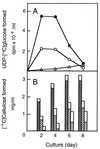Enhancement of cellulose production by expression of sucrose synthase in Acetobacter xylinum
- PMID: 9874763
- PMCID: PMC15084
- DOI: 10.1073/pnas.96.1.14
Enhancement of cellulose production by expression of sucrose synthase in Acetobacter xylinum
Abstract
Higher plants efficiently conserve energy ATP in cellulose biosynthesis by expression of sucrose synthase, in which the high free energy between glucose and fructose in sucrose can be conserved and used for the synthesis of UDP-glucose. A mixture of sucrose synthase and bacterial cellulose synthase proceeded to form UDP-glucose from sucrose plus UDP and to synthesize 1,4-beta-glucan from the sugar nucleotide. The mutant sucrose synthase, which mimics phosphorylated sucrose synthase, enhanced the reaction efficiency (Vmax/Km) on 1,4-beta-glucan synthesis, in which the incorporation of glucose from sucrose was increased at low concentrations of UDP. Because UDP formed after glucosyl transfer can be directly recycled with sucrose synthase, UDP-glucose formed appears to show high turnover with cellulose synthase in the coupled reaction. The expression of sucrose synthase in Acetobacter xylinum not only changed sucrose metabolism but also enhanced cellulose production, in which UDP-glucose was efficiently formed from sucrose. Although the level of UDP-glucose in the transformant with mutant sucrose synthase cDNA was only 1.6-fold higher than that in plasmid-free cells, the level of UDP was markedly decreased in the transformant. The results show that sucrose synthase serves to channel carbon directly from sucrose to cellulose and recycles UDP, which prevents UDP build-up in cellulose biosynthesis.
Figures



 , wild-type sucrose synthase cDNA; ▨, plasmid-free cells.
, wild-type sucrose synthase cDNA; ▨, plasmid-free cells.Similar articles
-
Cytosolic invertases contribute to cellulose biosynthesis and influence carbon partitioning in seedlings of Arabidopsis thaliana.Plant J. 2018 Jun;94(6):956-974. doi: 10.1111/tpj.13909. Epub 2018 Apr 17. Plant J. 2018. PMID: 29569779
-
Intermediatry steps in Acetobacter xylinum cellulose synthesis: studies with whole cells and cell-free preparations of the wild type and a celluloseless mutant.J Bacteriol. 1980 Sep;143(3):1142-50. doi: 10.1128/jb.143.3.1142-1150.1980. J Bacteriol. 1980. PMID: 7410313 Free PMC article.
-
Organ-specific expression of genes associated with the UDP-glucose metabolism in sugarcane (Saccharum spp. hybrids).BMC Genomics. 2023 Jan 13;24(1):18. doi: 10.1186/s12864-023-09124-8. BMC Genomics. 2023. PMID: 36639618 Free PMC article.
-
Cellulose biosynthesis and function in bacteria.Microbiol Rev. 1991 Mar;55(1):35-58. doi: 10.1128/mr.55.1.35-58.1991. Microbiol Rev. 1991. PMID: 2030672 Free PMC article. Review.
-
Structure--function characterization of cellulose synthase: relationship to other glycosyltransferases.Phytochemistry. 2001 Aug;57(7):1135-48. doi: 10.1016/s0031-9422(01)00048-6. Phytochemistry. 2001. PMID: 11430986 Review.
Cited by
-
Modulating Microbial Materials - Engineering Bacterial Cellulose with Synthetic Biology.ACS Synth Biol. 2024 Dec 20;13(12):3857-3875. doi: 10.1021/acssynbio.4c00615. Epub 2024 Nov 7. ACS Synth Biol. 2024. PMID: 39509658 Free PMC article. Review.
-
Evidence that sucrose loaded into the phloem of a poplar leaf is used directly by sucrose synthase associated with various beta-glucan synthases in the stem.Plant Physiol. 2004 Mar;134(3):1146-52. doi: 10.1104/pp.103.033167. Epub 2004 Feb 26. Plant Physiol. 2004. PMID: 14988476 Free PMC article.
-
Enhanced Chlorophyll Degradation Triggers the Pod Degreening of "Golden Hook," a Special Ecotype in Common Bean (Phaseolus vulgaris L.).Front Genet. 2020 Oct 6;11:570816. doi: 10.3389/fgene.2020.570816. eCollection 2020. Front Genet. 2020. PMID: 33133159 Free PMC article.
-
Overexpression of poplar xylem sucrose synthase in tobacco leads to a thickened cell wall and increased height.PLoS One. 2015 Mar 25;10(3):e0120669. doi: 10.1371/journal.pone.0120669. eCollection 2015. PLoS One. 2015. PMID: 25807295 Free PMC article.
-
From Nature to Lab: Sustainable Bacterial Cellulose Production and Modification with Synthetic Biology.Polymers (Basel). 2023 Aug 18;15(16):3466. doi: 10.3390/polym15163466. Polymers (Basel). 2023. PMID: 37631523 Free PMC article. Review.
References
-
- Geigenberger P, Langenberger S, Wilke I, Heineke D, Heldt H W, Stitt M. Planta. 1993;190:446–453.
-
- Delmer D P. J Biol Chem. 1972;247:3822–3828. - PubMed
LinkOut - more resources
Full Text Sources
Other Literature Sources

